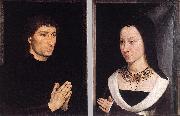Wholesale Oil Painting No Minimum |
|||||||||||
|
|
|||||||||||

|
|||||||||||
|
|
|
||||||||
MEMLING, HansNetherlandish Northern Renaissance Painter, ca.1435-1494 South Netherlandish painter of German origin. Together with Dieric Bouts I and Hugo van der Goes, he was one of the most important exponents of the new artistic developments that flourished in the southern Netherlands in the 15th century in the wake of Jan van Eyck, the Master of Fl?malle and Rogier van der Weyden. Their principal innovation was to apply optic realism to devotional or mystical subjects. Although Memling lived in the turbulent period of transition from the Burgundian ruling house to that of the Habsburgs, little of this is evident in his work. His commissions were almost exclusively from rich burghers in Bruges (bankers, merchants and politicians) or churchmen and the occasional aristocrat. Often they were foreigners, especially Italians, who had political or financial connections with the town, whose central economic position was to last only a few decades longer. They had Memling paint their portraits, bust or full length, in devotional paintings or on altarpieces for their chapel in Bruges or back home. He seems not to have received official commissions (from the town council or court). An exceptional proportion of this oeuvre has survived. Besides about 20 altarpieces, often in several panels and of considerable size, |
||||||||
|
|
||||||||
Tommaso Portinari and his Wife wh
Tommaso Portinari and his Wife wh Painting ID:: 8180 |
c. 1470
Oil on wood, 44.1 x 33,7 and 44,1 x 34 cm, respectively
Metropolitan Museum of Art, New York c. 1470 Oil on wood, 44.1 x 33,7 and 44,1 x 34 cm, respectively Metropolitan Museum of Art, New York |
|||||||
|
CONTACT US |

